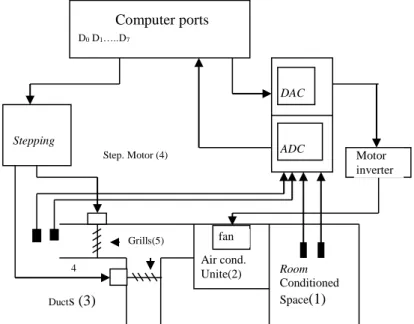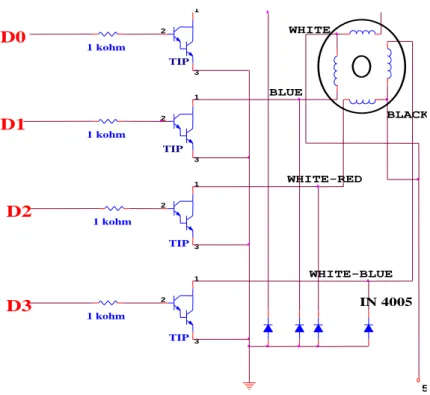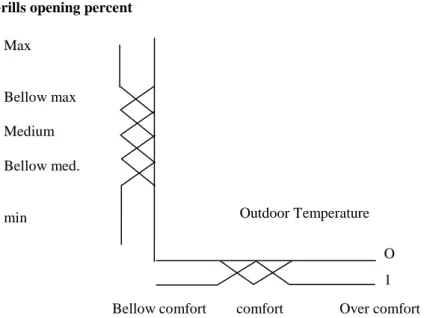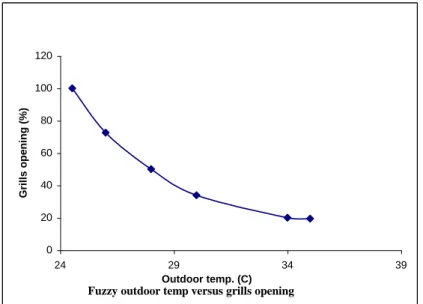Saber M. Abd Rabbo–Yehia El-Mashad
Mech. Eng. Dept., Faculty of Eng. (shoubra), Zagazig University, Benha Branch
FUZZY LOGIC CONTROL FOR ENERGY MANAGMENT OF AIR CONDITION SYSTEMS BASED ON OUTDOOR
CONDITIONS
1. Abstract
Conventional designs of air conditioning control system are compensated by a fresh air using either min. outdoor air or 100% outdoor air regardless the outdoor conditions of temperature and humidity. In the present work an air conditioning test model for the aim of energy management and saving is implemented. The proposed system has two-control loop first loop based on indoor conditions as well as the second one based on outdoor conditions. After processing the outdoor temperatures signals, computer is used to control the rotation of stepping motors actuation system which are fitted on fresh air and exhaust ports, and the fan motor speed through a proposed interface circuit. Fuzzy logic allows for the formulation of a technical control strategy-using element of every day language. Fuzzy logic was proposed to design a control strategy that adapts user needs which achieving both comfort level and energy compensation. A group of experiments are implemented to verify the relation between the outdoor conditions (temperature and humidity) and fresh air opening percent of grills ports. The experimental results shows that an introducing of outdoor condition (temperature &humidity) in its acceptable zone (24 to 26 dry bulb temperature) using a fuzzy logic strategy reduced with considerable percent the energy consumption level..
2. Key Words
Air condition-Outdoor condition-Fuzzy logic – Interface circuit – Stepping mo- tor.
3. Introduction
One of the major consumers of the total of all energy produced in the world is the heating and cooling of buildings. Hence increasing efficiency of these systems has a great affect on energy saving. These savings can be realized either by con- structional improvements such as better insulation or more efficient heating and
cooling systems or by using more intelligent control strategies for the operation of these devices
Christine H. [1] described an adaptive fuzzy control (AFC) algorithm to control hydronic-heating system, the performance of AFC was validated using simulation and laboratory test. Lee C. [2] provide background on fuzzy control, fuzzy controller is described first, including the input and the output membership functions [3],[4].
Chan Chen Y. and Jason M.[5] introduced an undergraduate laboratory platform for control system simulation and implementation using MATLAB[6]. The purpose of HVAC controls is to provide comfort in offices and manufacturing space. Supply air is the means of providing comfort in the conditioned zone. The air supplied to each zone must provide heating and cooling raise or lower humidity and provide air refreshment. Outdoor air is admitted to satisfy requirements for fresh air or to pro- vide free cooling. The minimum requirement for fresh outdoor air while the building is occupied is usually 10 percent of air handler’s capacity[7].
Khelassi A. et al [8] presented an approach to assessment of interaction and con- trol of two stage refrigeration system. The direct nyquist array(DNA) has been used jointly with the internal modal control to develop a method for analyzing and quanti- fying the interaction between subsystem variable.
The present work use outdoor temperature and humidity conditions through a fuzzy logic control loop which allow the temperature controller signal to operate the outdoor air damper or grills opening. This economizer loop activated whenever the outdoor temperature and humidity are in their acceptable comfort level to operate with maximum energy efficiency.
4. Setup description
To realize the idea of energy saving based on outdoor conditions (temperature and humidity). An air conditioning set up model is prepared, Figure 1 shows an outline diagram for such setup which is consists of the following main parts, Condi- tioned space (1) which is a wooden room prepared to simulate an air conditioned space, the room is insulated by a successive sandwiched layers of plywood, polyure- thane and plywood respectively, complete air conditioning units (2), a fan supply and return ducts(3) which are used to allow entire air from outside to the air condi- tioning unit, to mix with the return air from room. The ducts are insulated by wall glass and covered by a bright coat to reflect the sunlight as shown in Figure 2. To control the opening area of duct grill, stepping motors (4) are fitted on supply and return grills (5). Rotation motion of each stepper was converted into linear motion using rack and pinion mechanism, the rack have a curved groove which controls the blade angle of the grill. Using a spray humidifier changed relative humidity, finally a heat with a group of different power lamps are used as a thermal load.
T-type thermocouple are used to sense and measure temperature, transducer sig- nal is processed to a computer through analog to digital converter (ADC 0809).
Digital output serial port computer signal is converted into its corresponding analog one by using eight bit digital to analog converter module (DAC0808) as depicted in Figure 1, and used to control fan speed through inverter. Digital parallel port com-
puter signal (D0, D1, D7) are used to control the stepping motors switching circuits shown in Figure3. Opt-isolators devices are used to protect computer from any power surge.
Visual basic software code was written to control the system through fuzzy logic strategy
Figure1: Outline diagram for the proposed test section
Figure 2: Photo for the proposed test section Computer ports
Stepping Mo- tor
Swit ching
cir- cuit
DAC 0 808 ADC 08 09
Motor inverter
Room Conditioned Space(1) fan
Air cond.
Unite(2)
Ducts (3)
Step. Motor (4)
4
Grills(5) D0 D1…..D7
5 V TIP
122
1
3 2
TIP 122
1
3 2
TIP 122
1
3 2
TIP 122
1
3 2
D0
D1
D2
D3
1 kohm
1 kohm
1 kohm
1 kohm
Figure(3) Stepping switching circuit.
WHITE
BLACK BLUE
WHITE-RED
WHITE-BLUE IN 4005
Figure 3: Stepping switching circuit.
5. Fuzzy logic strategy
Fuzzy logic is a kind of logic using graded or quantified statements rather than ones that are strictly true or false. The results of fuzzy reasoning are not definite as those derived by strict logic. The fuzzy sets allow objects to have grades of member- ship μ from 0 to 1. These sets are represented by linguistic variable.
In an Fuzzy Logic Control (FLC), the dynamic behavior of a fuzzy system is characterized by a set of linguistic description rules based on knowledge base. The knowledge is usually of the form: IF (a set of conditions is satisfied) THEN (a set of consequence can be inferred). Since the antecedents and consequent of these IF- THEN rules are associated with fuzzy concepts (Linguistic terms), they are often called fuzzy conditional statements. Fuzzy control rule is a fuzzy conditional state- ment in which the antecedent is a condition in its application domain and the conse- quent is a control action for the system under control. Basically, a fuzzy control rule provides a convenient way for expressing control policy and domain knowledge.
Furthermore, several linguistic variable might be involved in the antecedents and conclusions of these rules.
For multi-input-multi-output (MIMO) fuzzy system, fuzzy control rule have the following forms:
Rule1:IF x is a1 and y is b1 THEN z is c1 and w is l1 as well as, Rule2:IF x is a2 and y is b2 THEN z is c2 and w is l2 finally, Rule3: IF x is an and y is bn THEN z is cn and w is ln
Where x,y,z,w are linguistic variables representing two process state variable and two control variable respectively ai, bi,ci, and li are linguistic values of the lin- guistic variables x,y,z and w in the universe of discourse U,V,P,Q respectively which can be written as:
μRi≡μ(ai and bi)→ci or li
Figure 4: Outdoor fuzzy temperature controller
Figure 4: shows the controller of the present work with two indoor inputs (tem- perature (Tidb) and humidity (Twb)) and two outdoor inputs (temperature (Todb) and humidity (Towb)) and the output of fan speed and grills opening. Figure 5 illustrates how one can approximate the desired control relation as membership function be- tween the outdoor temperature and the grills opening percent. The physical relations between the membership functions are used to build fuzzy rules. These rules are much simpler to implement and easier to debug and tune than piecewise linear func- tions.
Indoor sen- sors
Outdoor sensor
Room Controller
Fan
Grills stepping
Temperature
Humidity
Grills opening percent
Figure 5: Fuzzy membership function between outdoor temperature and grills opening percent
The linguistic sets of outdoor condition and the percent of fresh air through the duct grill opening was described as:
IF outdoor temperature Is over comfort and humidity is high THEN grills opening are min.
IF outdoor temperature Is comfort and humidity is high THEN grills opening are medium.
IF outdoor temperature is under comfort and humidity is high THEN grills opening are below medium
IF indoor temperature Is over comfort and humidity is med.
THEN Grills opening are below medium
IF outdoor temperature Is comfort and humidity is medium THEN Grills opening are below max
IF outdoor temperature Is under comfort and humidity is med.
THEN Grills opening are below medium
IF outdoor temperature Is over comfort and humidity is low THEN Grills opening are below max.
IF outdoor temperature Is comfort and humidity is low THEN Grill opening are max.
IF outdoor temperature Is under comfort and humidity is low THEN Grills opening are below max.
The controller was described with the following sets of linguistic rules between temperature and fan speeds.
Bellow comfort comfort Over comfort O 1 Max
Bellow max Medium Bellow med.
min Outdoor Temperature
IF indoor temperature Is over comfort and humidity is high THEN fan speed is high
IF indoor temperature Is comfort and humidity is high THEN fan speed is medium
IF indoor temperature is under comfort and humidity is high THEN fan speed is very low
IF indoor temperature Is over comfort and humidity is med.
THEN fan speed is medium
IF indoor temperature Is comfort and humidity is medium THEN fan speed is low
IF indoor temperature Is under comfort and humidity is med.
THEN fan speed is very low
IF indoor temperature Is over comfort and humidity is low THEN fan speed is medium
IF indoor temperature Is comfort and humidity is low THEN fan speed is zero
IF indoor temperature Is under comfort and humidity is low THEN fan speed is zero
6. Experiment Results and Discussions
To verify the relation between the outdoor conditions and percentage of grills openings (X: ventilation air ratio), transducers are fitted in two different locations.
– Outdoor sensors to measure outdoor temperature and humidity.
– Indoor sensors to measure indoor temperature and humidity.
Illustrating to Figure 6 air mass flow distributions through the proposed test sec- tion are shown, the relation between enthalpy of air inlet to cooling coil (h1), enthal- py of air out door(ho), enthalpy of air inside the conditioned space(hI), and the venti- lation air ratio(X) can be written as:
h1=Xho+(1-X).hi
The amount of heat transfer through the evaporator can be written as Qevap=mt∆h
Measuring Indoor temperatures and humidity at different thermal loads and con- stant outdoor boundary conditions has carried out an experiment. A group of Previ- ous experiment has been repeated at different opening percent of grills (at 20%, 40%, 60%, 80%, 100 %), and the same outdoor conditions. Another group of the same experiments has been implemented at different Outdoor conditions.
Figure 6: Air distribution through ducts
Figure 7 shows a relation between the conditioned temperatures versus the con- sumed evaporating energy at different percent of fresh air grills opening and con- stant outdoor conditions of 32 Co dry bulb temperature and 20 Co wet bulb tempera- ture. While Figure 8 shows also the same relations but at another constant outdoor conditions of 26 Co (dry) bulb temperature and 20 Co average wet bulb temperature.
As well as Figure 9 shows the relation between conditioned air bulb temperature and consumed energy at different out door conditions and constant fresh air grills opening. As depicted in Figure 7, it is noticed that consumed energy decreases when the desired conditioned temperature increase. With the variation of fresh air grills opening the consumed energy increase as fresh air grills opening increase. This amount of energy deceased when the outdoor conditions decreased as shown in Figure 9. This work introduces a control loop based on outdoor conditions (tempera- ture and humidity). The above mentioned consumption of evaporating energy will be reduced with a considerable amount by introducing such outdoor conditions con- trol loop. If the outdoor temperature achieved the desired comfort conditioned (tem- perature and humidity) the conditioning unit operates only as distributing fan, hence considerable energy saving has been achieved for such operating conditions. The utilization of outdoor conditions will be reduced if such outdoor conditions not achieved the required comfort conditions.
Conditioned indoor dry bulb temp versus Qevap., at outdoor conditions of wet bulb temp=20 C, and dry bulb temp.=32 C 0
500 1000 1500 2000
20 25
Indoor dry bulb temp. (C)
Qevap.(Watt)
X=20%
X=40%
X=60%
X=80%
X=100%
Figure 7: Conditioned temperatures vs. consumed evaporating energy -1 mo
Conditioned space Cooling
coil mo
mi
mt
Condtitioned dry bulb temperature versus evaporated heat outdoor conditions(wet bulb temp=20 C,dry bulb temp =26 c) 0
200 400 600 800 1000
20 21 22 23 24 25 26
Indoor dry bulb temperature C
Qevap (Watt)
x=20%
X=40%
X=60%
X=80%
X=100%
Expon. (X=40%)
Figure 8: Conditoned temperatures vs. consumed evaporating energy –2
Indoor dry bulb temp versus Qevap. At full grills opening (x=100%) at different outdoor conditions
0 500 1000 1500 2000 2500
20 25
Indoor dry bulb temp C
Qevap.(Watt)
out door temp =34 C Outdoor temp=26
Figure 9: Conditoned temperatures vs. consumed evaporating energy –3 Figure 10 shows the results of outdoor temperature and the grills opening which controlled through a fuzzy logic controller. The obtained results shows that when the outdoor condition verify the comfort temperature at a range between 24 Co and 26 Co, fuzzy controller send a signal to a stepping motors to fully open the grills and the conditioning unit operates at its minimum energy consumption level. When the outdoor conditions not verify the comfort one, the grills opening become to decrease and the energy consumption level become to increase. The results show that the utilization zone of outdoors temperate lies 24 Co and 26 Co at an acceptable relative humidity.
Fuzzy outdoor temp versus grills opening 0
20 40 60 80 100 120
24 29 34 39
Outdoor temp. (C)
Grills opening (%)
Figure 10: Fuzzy aoutdoor temperature vs. grills opening
7. Conclusion
In the present work an air conditioning test model for the aim of energy man- agement and saving is implemented. The proposed system has two-control loop first loop is the conventional control loop based on indoor conditions as well as the sec- ond proposed one is the fuzzy logic controller based on outdoor conditions. Due to uncertainties of outdoor conditions, experimental results show that on-line fuzzy logic control strategy is a powerful tool to control these uncertainties. The experi- mental results shows that an introducing of outdoor condition (temperature
&humidity) in its acceptable zone (24 to 26 dry bulb temperature) using a fuzzy logic control strategy reduced with considerable percent the energy consumption level and the system will operate with maximum energy efficiency.
References
[1] Christine H., “Adaptive fuzzy temperature control hydronic heating systems”, IEEE Control Systems Magazine, PP39-48, April 2000.
[2] Lee C., ” Fuzzy logic in control system fuzzy logic controller part1”, IEEE, Trans. Systems, Man Cyber. ,Vol. 20, no2, PP404-418, 1990
[3] Lefteri H., and Robert E., “Fuzzy and neural approaches in engineering”, JOHN WILEY&SONS INC. Publication, 1999.
[4] Leonid R., “Fuzzy controllers”, Newnes, Oxford OX2, 8DP, 1997.
[5] Chon Chen Y. &Jason M., ”An undergraduate laboratory platform for control system design simulation and implementation”, IEEE Control Systems Magazine, PP12-20, June 2000.
[6] Natick M., ”MATLAB External Interface Guide”, Mathworks, 1998.
[7] Luciano, J.,” Energy conservation techniques for hospital operating rooms”, ASHRAE jour- nal, May 1983.
[8] Khelassi A., et al, “Assessment of interaction and control of a two stage refrigation system”, Arab-African Conference for Refrigeration and Air Conditioning, Cairo, Egypt, PP1-12, May 2001.






